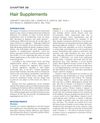TLDR Hair follicles in injured skin can quickly accumulate minerals, especially calcium and phosphorus.
The study from 1971 investigated the mineralization of hair follicle tissue in hypercalcemic rats. It was found that hair follicles were particularly prone to mineralization following skin injury. Chemical and X-ray diffraction analyses confirmed that mineral deposits, indicated by increased calcium and phosphorus, began forming in hair follicle tissue 6-12 hours after a mild crush injury in rats treated with dihydrotachysterol (DHT), and 24-48 hours in non-treated rats. X-ray diffraction showed a diffuse apatite pattern. An increase in calcium content was observed within 3 hours of injury, likely due to calcium binding rather than mineral deposition, and was not related to DHT dosing.
12 citations
,
December 1965 in “Immunology and Cell Biology” Mild skin injury can trigger mineral deposits in rat skin, even without full calciphylactic response.
82 citations
,
November 1959 in “Annals of the New York Academy of Sciences” 11 citations
,
January 1957 in “Journal of Histochemistry & Cytochemistry” Ca 45 mainly enters rat skin and eye through biosynthesis and may be adsorbed in cartilage and glands.
 1533 citations
,
October 2008 in “Endocrine reviews”
1533 citations
,
October 2008 in “Endocrine reviews” Mice without the vitamin D receptor have bone issues and other health problems, suggesting vitamin D is important for preventing various diseases in humans.
 2 citations
,
July 2018 in “Elsevier eBooks”
2 citations
,
July 2018 in “Elsevier eBooks” Some supplements may help with hair loss, but there's not enough strong evidence to recommend them without doctor advice.
276 citations
,
April 2003 in “Molecular endocrinology” Vitamin D is important for bones, hair, blood pressure, and breast development.
23 citations
,
October 2009 in “Gastroenterology” Vitamin D is crucial for bone health and preventing serious diseases.
 1308 citations
,
March 1998 in “Journal of bone and mineral research”
1308 citations
,
March 1998 in “Journal of bone and mineral research” The vitamin D receptor is crucial for bone health and affects various body systems, with mutations potentially leading to disease.



